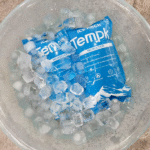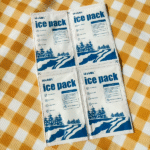Glace sèche, solidified carbon dioxide (Co₂), plays a crucial role in temperature-sensitive industries such as cold chain logistics and food transportation. Cependant, storing dry ice in an airtight container like a Ziplock bag can lead to dangerous consequences. Dans cet article, we’ll explore why this is unsafe and provide alternative solutions for dry ice storage, all aligned with the latest 2025 Innovations de la chaîne du froid.
-
What are the risks associated with Ziplock bags for dry ice storage?
-
What are the best practices for safe dry ice handling and transport?
-
Quoi 2025 trends are shaping the future of dry ice packaging and transportation?
Can Dry Ice Be Safely Stored in a Ziplock Bag?
The Risks of Using Ziplock Bags for Dry Ice Storage
Dry ice sublimates at an extremely low temperature of -78.5°C (-109.3°F), converting directly into CO₂ gas. If this gas is trapped inside a Ziplock bag, the pressure buildup can cause it to burst or even explode. Sealing dry ice in a Ziplock bag creates a hazardous environment, as the plastic material cannot withstand the intense cold, and the gas pressure may rupture the bag, posing risks to both people and products.
Key Insight: Ziplock bags are not designed to allow gas to escape, which is why using them for dry ice storage is risky and can result in “dry ice bombs”—explosive ruptures caused by excessive CO₂ pressure buildup.
Why Is Using a Ziplock Bag Dangerous?
-
Accumulation de pression: Comme la glace sèche sublime, it releases significant amounts of CO₂ gas. If sealed in a Ziplock bag, ce gaz ne peut pas s'échapper, leading to rapid pressure accumulation. Au fil du temps, this pressure will cause the bag to swell and potentially burst, releasing CO₂ gas violently.
-
Explosion Risk: The high-pressure buildup inside a sealed Ziplock bag can turn it into a bomb. As CO₂ gas expands, the force generated can rupture the plastic, causing serious injury or damage.
-
Asphyxation: CO₂ is a colorless, odorless gas that displaces oxygen. In an enclosed space, the rapid release of CO₂ can lead to asphyxiation, which may cause dizziness, loss of consciousness, or even death.
Exemple du monde réel: A logistics company once experienced a rupture while transporting dry ice in a Ziplock bag. The uncontrolled gas buildup resulted in a mess, and the shipment integrity was compromised, highlighting the importance of using proper containers for dry ice.
Best Practices for Storing and Transporting Dry Ice
1. Use Proper Containers for Dry Ice
Rather than using a Ziplock bag, store dry ice in containers that are designed to handle the unique needs of CO₂. This includes glacières ventilées, specialized dry ice bags, ou conteneurs isolés. These containers allow gas to escape while maintaining the cold temperature of the dry ice, empêchant une accumulation dangereuse de pression.
Conseil: Choisir sacs à glace sec ventilés ou refroidisseurs isolés with built-in gas release mechanisms to ensure both safety and effectiveness during transport.
2. Ensure Ventilation for Gas Release
Proper ventilation is crucial when handling dry ice. Optez toujours pour ventilé ou open containers that allow the CO₂ gas to safely escape. This prevents the dangerous buildup of pressure that could otherwise lead to explosions. Never store dry ice in completely airtight containers.
3. Manipulez la glace sèche en toute sécurité
When transporting or handling dry ice, ensure proper safety measures are taken to avoid frostbite or injuries. Utilisez toujours gants isolés, pinces, or other safety equipment when touching dry ice. Never handle it with bare hands, as its extreme cold can cause severe skin damage.
Handling Tip: Store dry ice away from sensitive items comme la nourriture, électronique, and fragile materials to prevent freezer burn or damage.
4. Monitor Temperature and CO₂ Levels
If transporting dry ice over long distances, temperature monitoring tools et Détecteurs de co₂ should be employed. These devices will ensure the temperature stays within the desired range and that CO₂ gas does not accumulate to dangerous levels during the journey.
Alternatives to Ziplock Bags for Dry Ice Storage
1. Vented Coolers and Insulated Bags
Optez pour glacières ventilées ou insulated dry ice bags to maintain a safe temperature while allowing the gas to escape. These containers are specifically designed to ensure safe handling and transport, as they are equipped with gas release valves that prevent dangerous pressure buildup.
2. Dry Ice Storage Boxes
Specialized dry ice storage boxes are available that allow controlled sublimation of CO₂ gas. These containers are designed to handle the extreme cold and ensure that the gas is safely released.
3. Specialized Dry Ice Bags
Certain manufacturers provide sacs à glace sec made from materials designed to withstand cryogenic temperatures. These bags often feature trous de ventilation that allow the safe escape of gas.
| Type de conteneur | Pros | Inconvénients | Mieux pour |
|---|---|---|---|
| Vented Coolers | Excellente isolation, gas release | Heavier and more expensive | Long-distance transport |
| Insulated Dry Ice Bags | Léger, portable, CO₂ release valve | May not last as long for large amounts | Short-term transport or storage |
| Dry Ice Storage Boxes | Built for dry ice, safe and insulated | Nécessite plus d'espace | Safe storage in warehouses |
2025 Trends in Dry Ice Packaging and Transportation
Emerging Innovations in Dry Ice Handling
The dry ice packaging industry is evolving to meet modern safety and environmental needs. Some key trends emerging in 2025 inclure:
-
Solutions d'emballage intelligents: With the rise of IoT technologies, dry ice containers now feature temperature and CO₂ sensors. These smart systems provide real-time data on the condition of the dry ice, helping companies maintain safe and optimal temperatures throughout transport.
-
Emballage respectueux de l'environnement: The focus on durabilité continue de croître, with biodegradable bags and microperforated plastic bags becoming more common. These innovations reduce plastic waste while providing a safer method for handling dry ice.
-
Automatisation dans la logistique de la chaîne du froid: Automation in the logistics sector is enhancing the precision of Envois sensibles à la température. Robotic systems are used to handle dry ice and other refrigerants more safely, reducing human error and increasing efficiency.
Insistance au marché
La demande de safe dry ice storage and transport solutions continue de croître. Consumers and businesses alike are prioritizing eco-friendly and cost-effective solutions while ensuring safety and efficiency. With the advancement of emballage intelligent et Systèmes automatisés, the future of dry ice handling looks poised to enhance both safety and sustainability.
FAQ
Can I use a Ziplock bag for dry ice storage?
Non, a Ziplock bag cannot release CO₂ gas safely, which can lead to dangerous pressure buildup and rupture. Always use a vented container.
What’s the best way to store dry ice?
Use a vented cooler or specialized dry ice bag that allows CO₂ to escape. Never store dry ice in an airtight container.
How can I transport dry ice safely?
Ensure your dry ice is stored in a vented container with proper insulation. Always ensure adequate ventilation and handle with safety gear.
Conclusion et recommandations
En résumé, placing dry ice in a Ziplock bag is highly unsafe due to the risks of pressure buildup, explosion, and asphyxiation. Always use containers designed for dry ice storage, such as vented coolers or insulated dry ice bags. Incorporating proper ventilation and safety protocols ensures the safe transport and handling of dry ice.
Action Step: For safer dry ice storage and transport, invest in vented containers et utiliser temperature monitoring tools to ensure the safe and effective use of dry ice in your logistics operations.
À propos du tempk
Et tempk, we specialize in providing advanced cold chain solutions that ensure temperature-sensitive products stay within the required range. Nos produits, y compris glacières ventilées et specialized dry ice bags, are designed for maximum safety and efficiency during shipping. Trust Tempk to provide the most effective cold chain logistics for your needs.
Take action today! Contact us for expert advice on optimizing your cold chain logistics and improving the safety and efficiency of your dry ice transport.
























